Clark Street plan looks to revitalize Rogers Park thoroughfare
By Igor Studenkov For Chronicle Media — March 6, 2018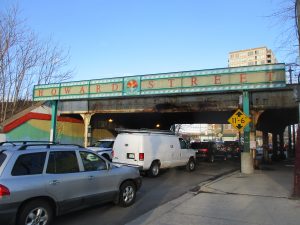
The Vision Clark Street plan recommended putting gateway signage at Howard/Clark and Devon/Clark intersections, similar to this Howard Street gateway signage at the Howard Street Union Pacific North Line underpass. (Photo by Igor Studenkov/for Chronicle Media)
Clark Street is one of Chicago’s major corridors — and the section that runs through Rogers Park neighborhood, from the city’s border with Evanston to Devon Avenue, is no exception.
But in recent years, many local residents and businesses felt that the street hasn’t gotten as much investment s it should have. That is why, in April 2017, the Rogers Park Business Alliance launched the Vision Clark Street Corridor Master Plan. The idea was to devise strategies that could be used to improve the corridor while making sure that it wouldn’t adversely affect local residents and businesses.
The final version of the plan was unveiled on Dec. 12. Since then, RPBA has been working with the community organizations and other stakeholders to figure out which ideas could be implemented first. But because even the shortest-term ideas take time to implement, it may be months, if not years, before residents and businesses will see the results.
According to its website, RPBA was established in 1993. As the name suggests, it works to promote Rogers Park businesses and economic development. Among other things, it operates a business incubator and three Special Service areas – special taxing districts where local property owners agree to pay a little extra on their property tax to fund certain local improvements. One of those SSA’s — Special Service Area 24 — includes a portion of the Clark Street corridor between Albion and Birchwood avenues.
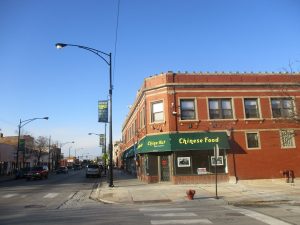
The plan recommends sprucing up vacant storefronts with photos or art, similar to what’s already being done with this vacant storefront at 7101 N Clark St. (Photo by Igor Studenkov/for Chronicle Media)
The process of putting the plan together went through several steps. RPBA assembled a Project Steering Committee, which was made up of representatives from its own organization, several Clark Street businesses and the office of Ald. Joe Moore (49th), whose ward includes most of the corridor save for the section between Devon and Albion avenues. It contracted downtown Chicago-based Lakota Group, Arlington, Va.-based Community Land Use + Economics Group, and Chicago-based Sam Schwartz Engineering to handle the more technical aspects of the planing process. Together, they collected input from “hundreds” of community stakeholder organizations and institutions, and held three community open houses to get resident feedback.
The final version of the plan proposed a number of short-term and long-term recommendations that RPBA could either implement on its own or work with other entities to implement. They are grouped into seven subject areas — community identity, public art and events, building and streetscape improvements, gateway improvements, transportation, land development and business development.
Promotion and advertising plays an important role in the plan. While it notes that Clark Street has the “Celebrate Clark Street” brand, it was determined that it should be updated and utilized more extensively. It suggested adding “gateway signage” to mark where the corridor starts. A number of neighborhoods — including Andersonville further south along Clark Street, West Side’s Little Village and South Side’s Bronzeville — have some kind of prominent signs signaling that the neighborhood exists and welcoming visitors. And the plan notes that, when it comes to the corridor’s reputation, safety — and perception of safety — is a major concern.
To address those issues, the plan suggests using the Clark Street brand in things like stickers and tote bags, and using the brand in local art installations. It suggested putting more emphasis on the corridor’s history, encouraging residents and visitors to explore and learn about historically significant areas. To promote safety, the plan suggested focusing investments in “high-crime areas,” using social media to spread awareness about safety issues and using a local police station plaza as a community hub that would feature local artists and community events.
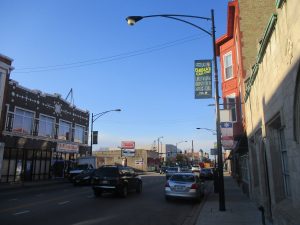
Vision Clark Street plan calls for RPBA to utilize “Celebrate Clark Street” brand more, beyond the banners like this one. (Photo by Igor Studenkov/for Chronicle Media)
Community art and community events are another important area. As the plan notes, like much of Rogers Park, Clark Street is home to many murals and sculptures, and events like the Celebrate Clark Street festival are major draws. But it argues that the corridor could benefit from more of it. The plan notes that some of community’s most colorful murals are either along or under “L” and Metra embankments, so it called for putting more murals and other public art at and closer to Clark Street. On longer term, it called for interactive public art. The plan also called for the establishment of new public spaces with amenities such as kiosks, as well as adding more amenities to spaces that already exist. And it recommends not only encouraging more regular events, but doing more to ensure that they reflect the many cultures that are part of the corridor.
The next major aspect of the plan has to do with the way the neighborhood looks. It calls for sprucing up store and business signage, replacing damaged awnings and helping property owners improve building facades. As the plan notes, Clark Street already has resources businesses can take advantage of, including RPBA’s business improvement program and the City of Chicago’s Small Business Improvement Fund. Both provide rebates of up to 50 percent for building improvements, though the city’s program offers a bigger rebate. While RPBA’s rebate is capped at $5,000, the SBIF rebate is up to $150,000.
The plan calls for doing more outreach to Clark Street businesses to let them know those resources exist. It also recommends providing educational workshops to help property owners make improvements and offering awards for building improvements to provide a further incentive.
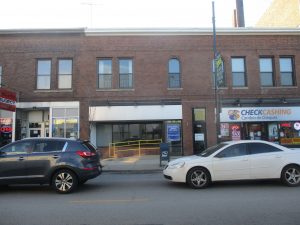
Vision Clark Street has a number of recommendations to help fill vacant storefronts along Clark Street. (Photo by Igor Studenkov/for Chronicle Media)
The plan further recommends that RPBA launch a program to help property owners fill vacant storefronts and use public art to make them more attractive until they are filled. Finally, the plan calls for creating design guidelines for more attractive, bilingual signs.
When it comes to streets, the plan suggests sprucing up the sidewalks by adding new trees and/or replacing the dead ones, adding other green elements, kiosks and street art, as well as garbage cans, recycling bins, benches and other “street furniture.” It further recommends RPBA find two places to add “people spots” — temporary platforms that would go over the parking lanes during warmer months. The concept has been implemented in other parts of Chicago and elsewhere in the country. In this particular case, the idea is to help businesses who may be interested in providing outdoor seating and dining. To improve pedestrian crossings, the plan calls for painting crosswalks at major intersections within the corridor. And the plan emphasizes the importance of figuring out a long-term solution to traffic issues caused by students going to and from Chicago Math and Science Academy charter school, which is located near the intersection of Clark Street and Chase Avenue.
The plan goes on to state that, while putting gateway signage is important, RPBA should also work to improve the appearance and traffic flow at the nearby areas. At the intersection of Howard and Clark streets, the plan calls for improving the park space at the southwest corner of the intersection “to create a space that not only looks open, but feels more safe and welcoming.”
At the Devon Avenue/Clark Street intersection, the plan calls for changing the bus turnaround so that, instead of looping counterclockwise, entering at Ashland Avenue and then turning back onto Clark Street, they would turn the other way around. This would allow PRBA to add more streetscaping in the Clark Street median and around the turnaround.
Turning to transportation, the plan noted that the corridor is served directly by the Route 22 bus, with routes 36 and 151 using the aforementioned Clark/Devon turnaround as their final northern stop. In addition, several more CTA and Pace routes cross Clark Street, and Union Pacific North Metra line and Red, Purple and Yellow lines stopping at the walking distance of the corridor. The plan suggests building on that, working with CTA and Metra to improve bus stops and the Rogers Park Metra station, working with Clark Street businesses to add bike parking, adding signs to help bike and transit users find their way around, improving pedestrian crossing and, if the number of cyclists along Clark Street increases, consider looking into adding bike lanes.
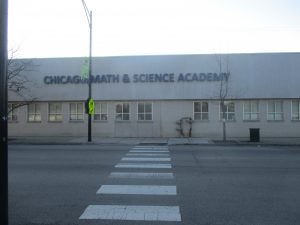
Vision Clark Street recommends improving the pedestrian crossings at Chicago Math and Science Academy charter school. (Photo by Igor Studenkov/for Chronicle Media)
The final major area is economic development and the way it affects community vitality. The plan acknowledges that it is a tricky issue — while the organizations involved want to take full advantage of the community assets to encourage new and existing businesses, they are conscious of the fact that such development can lead to uptick and property values, which can drive renter residents and businesses out of the community. The plan tries to encourage development while trying to preserve the neighborhood character and helping local businesses avoid displacement. The plan suggested establishing community goals for what it wants from new and existing buildings in terms of height, density, the use of ground floors, parking and availability of affordable housing. It also calls for establishing design guidelines and potentially applying for zoning changes. The plan would encourage “residential infill” to add more units to residential lots by, for example, adding smaller “granny flat” buildings, as well as potentially converting first-floor retail spaces into residential units. It also suggests that RPBA take an active role in recruiting developers and businesses to major sites. The plan also suggests creating a program to help developers rehabilitate buildings that the community considers “important archtectural assets,” establish a lease guarentee programs to encourage commercial business owners to rent to local businesses as opposed to national chains, which are seen as a safer choice; creating a commercial community land trust, which would help local businesses avoid rent increases by “separat[ing] the ownership of the land and the buildings.” And, perhaps more controversially, the plan suggests looking into establishing Tax Increment Financing districts to help create funds for development.
When a TIF district is created, the amount of tax revenue taxing bodies collect is frozen. When taxes increase, the extra money that would normally go to Chicago schools, parks, transit systems and other tax-collecting bodies would get deposited into a TIF fund. While this helps to create development funding, TIFs have been criticized for siphoning tax dollars from public services.
The final set of suggestions deals with helping new and existing small businesses get off the ground and keep operating. That included helping businesses find more ways for businesses, especially food businesses, to distribute products — ways that don’t require customers to set foot inside the spaces, as well as using surveys to measure how businesses are doing. Longer-term ideas included providing one-to-one technical assistance to businesses, creating a business incubator geared toward food-related businesses, developing a program to help business tenants buy their spaces outright a way a resident tenant would buy a condo, and create a program where commercial property owners would offer “percentage leases” — in exchange for lowering the rent, the landlords would get a percentage of the tenants’ gross sales.
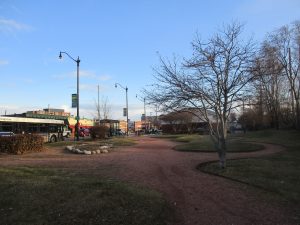
Vision Clark Street plans calls for improvements of this park at the southwest corner of Clark and Howard streets. (Photo by Igor Studenkov/for Chronicle Media)
Actually making all of these recommendations a reality is another matter. The plan outlines which ideas would get priority, how they would be funded and who RPBA would work with the develop them.
Carolina Juarez, a RPBA staff member who manages Special Service Area 24 and served a member of the plan steering committee, said that they already been discussing what could be implemented first.
“We have put together five committees comprised of community stakeholders and led by RPBA board members to take on the implementation process of the plan,” she explained. “The idea is to have the community take ownership of this plan with guidance from the Rogers Park Business Alliance.”
By the end of February, the committees are expected to choose at least three recommendations that could be implemented immediately, Juzarez said. But because even those recommendations would take months, if not longer, it is unclear how long it would be before they are implemented.
“Even the short-term recommendations will take time, so at this point it is very difficult to know how long things will take,” Juarez said. “What we do know is that the process has begun and that people are beginning to feel excited about the possibilities for Clark Street in Rogers Park.”
For more information about Vision Clark Street, visit: https://rpba.org/2017/12/3397/
Get your free subscription of the Cook County digital edition
— Clark Street plan looks to revitalize Rogers Park thoroughfare —







